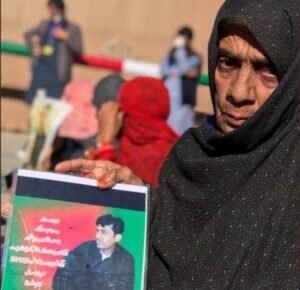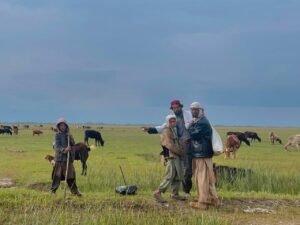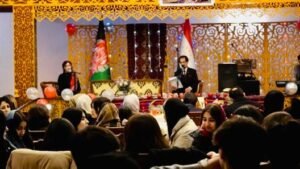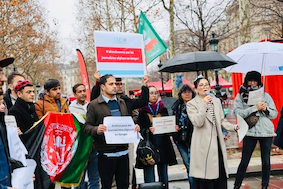The Need for a People’s Revolution in Pakistan: A Path to Redemption

A gathering of PTM supporters. Photo from Manzoor Pashteen's X account.
By Fatima Chaudhary
In recent years, Pakistan has found itself grappling with a severe convergence of crises that threaten not only its political stability but also the very fabric of its society. The country’s chronic political dysfunction, economic downfall, and rising security challenges have led to speculation about whether Pakistan is on the cusp of a revolution. This debate has intensified since the resignation of former Bangladeshi Prime Minister Sheikh Hasina, raising comparisons between Pakistan’s current state and the popular uprising that took place in Bangladesh.
The turmoil in Pakistan, particularly since the ouster of former Prime Minister Imran Khan in April 2022, has widened the gap between the state and its citizens. The economy is in freefall, governance has collapsed, and millions of Pakistanis are struggling to make ends meet. In this volatile situation, the notion of a people’s revolution, driven largely by the frustrations of the younger generation, seems less far-fetched than ever before.
The economic situation in Pakistan is dire. As the second-largest country in South Asia, it now has the highest inflation rate in the region, making daily life unbearable for many. According to the Pakistan Economic Survey, over 12.5 million people live below the poverty line, and another 95 million are battling poverty. Unemployment is rampant, with an 11% rate—the highest in South Asia—and more than 4.5 million young people are without jobs. The desperation has led to a mass exodus, with 1.6 million Pakistanis leaving for better opportunities abroad, primarily in the Middle East and Europe, over the last two years.
The government’s border-fencing projects with Afghanistan and Iran, intended to formalize the economy and enhance security, are instead deepening the crisis. The new border regulations threaten the livelihoods of young Pakistanis who work in the informal economy. Additionally, the installation of an internet firewall could stifle the freelance sector, which has been a crucial economic outlet for the country’s youth. These policies are exacerbating unemployment and economic uncertainty, especially in the already restive regions of Khyber Pakhtunkhwa and Balochistan.
Young Pakistanis are becoming increasingly disillusioned with the state. Youth movements like the Pashtun Tahaffuz Movement (PTM), led by Manzoor Pashteen, and the Baloch Yakjehti Committee, led by Mahrang Baloch, have captured the imagination of young people in conflict-ridden areas. These movements, though regional in nature, reflect the broader dissatisfaction among the country’s younger generations, who are angry at what they perceive as state repression and neglect.
In provinces like Balochistan and Khyber Pakhtunkhwa, armed resistance against the state is already a reality. Local groups have taken control of significant territories, creating a ripple effect that is felt across other regions. This unrest could spread to more populous areas like Punjab and Sindh, where deteriorating living standards have already driven many professionals and skilled laborers to seek a better life abroad. If this mass migration continues, Pakistan could soon face a tipping point where those left behind decide that enough is enough.
Pakistan’s political structure, which many describe as “military rule with a civilian façade,” is also under strain. While the military remains the most powerful institution in the country, its influence over public opinion appears to be waning. The May 9 protests, during which PTI supporters attacked military installations, marked a significant shift in how the Pakistani public views the military establishment.
The recent internal purges within the military, including the court-martial proceedings against former General Faiz Hameed, have added to the institution’s woes. The military’s struggles to maintain control and suppress dissent reflect a broader decline in its authority, which could embolden revolutionary forces within the country. Should another major uprising occur, it is unclear whether the military would be able to weather the storm as it did on May 9.
Given the political, economic, and social conditions in Pakistan, the question remains whether a revolution is inevitable. The nation is at a critical juncture, and without meaningful reform, public unrest may soon reach a boiling point. A people’s revolution may be the only way to reclaim Pakistan from its downward trajectory and set the country back on a path of stability and growth.
The masses, led by the youth, are increasingly demanding a system that works for them, not against them. As Pakistan’s situation continues to deteriorate, the possibility of a large-scale uprising looms larger. Whether the revolution comes from the youth or a broader coalition of dissatisfied citizens, one thing is clear: Pakistan’s future depends on its people taking a stand for meaningful change.
Fatima Chaudhary is a lecturer at a private university in Punjab province.
Note: The contents of the article are of sole responsibility of the author. Afghan Diaspora Network will not be responsible for any inaccurate or incorrect statement in the articles.









